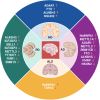The interplay between epitranscriptomic RNA modifications and neurodegenerative disorders: Mechanistic insights and potential therapeutic strategies
- PMID: 39691424
- PMCID: PMC11649393
- DOI: 10.1002/ibra.12183
The interplay between epitranscriptomic RNA modifications and neurodegenerative disorders: Mechanistic insights and potential therapeutic strategies
Abstract
Neurodegenerative disorders encompass a group of age-related conditions characterized by the gradual decline in both the structure and functionality of the central nervous system (CNS). RNA modifications, arising from the epitranscriptome or RNA-modifying protein mutations, have recently been observed to contribute significantly to neurodegenerative disorders. Specific modifications like N6-methyladenine (m6A), N1-methyladenine (m1A), 5-methylcytosine (m5C), pseudouridine and adenosine-to-inosine (A-to-I) play key roles, with their regulators serving as crucial therapeutic targets. These epitranscriptomic changes intricately control gene expression, influencing cellular functions and contributing to disease pathology. Dysregulation of RNA metabolism, affecting mRNA processing and noncoding RNA biogenesis, is a central factor in these diseases. This review underscores the complex relationship between RNA modifications and neurodegenerative disorders, emphasizing the influence of RNA modification and the epitranscriptome, exploring the function of RNA modification enzymes in neurodegenerative processes, investigating the functional consequences of RNA modifications within neurodegenerative pathways, and evaluating the potential therapeutic advancements derived from assessing the epitranscriptome.
Keywords: Alzheimer's disease; Parkinson's disease; RNA modifications; epitranscriptomics; neurodegeneration.
© 2024 The Author(s). Ibrain published by Affiliated Hospital of Zunyi Medical University (AHZMU) and Wiley‐VCH GmbH.
Conflict of interest statement
The authors declare no competing interests associated with the publication of this review article.
Figures




Similar articles
-
Functional interplay within the epitranscriptome: Reality or fiction?Bioessays. 2022 Feb;44(2):e2100174. doi: 10.1002/bies.202100174. Epub 2021 Dec 6. Bioessays. 2022. PMID: 34873719 Review.
-
Epitranscriptomic Regulations in the Heart.Physiol Res. 2024 Apr 18;73(Suppl 1):S185-S198. doi: 10.33549/physiolres.935265. Epub 2024 Apr 18. Physiol Res. 2024. PMID: 38634649 Free PMC article. Review.
-
Epitranscriptomics as a New Layer of Regulation of Gene Expression in Skeletal Muscle: Known Functions and Future Perspectives.Int J Mol Sci. 2023 Oct 13;24(20):15161. doi: 10.3390/ijms242015161. Int J Mol Sci. 2023. PMID: 37894843 Free PMC article. Review.
-
Insights into the regulatory role of RNA methylation modifications in glioma.J Transl Med. 2023 Nov 14;21(1):810. doi: 10.1186/s12967-023-04653-y. J Transl Med. 2023. PMID: 37964279 Free PMC article. Review.
-
RNA Modifications and Epigenetics in Modulation of Lung Cancer and Pulmonary Diseases.Int J Mol Sci. 2021 Sep 30;22(19):10592. doi: 10.3390/ijms221910592. Int J Mol Sci. 2021. PMID: 34638933 Free PMC article. Review.
Cited by
-
Epitranscriptomic alterations induced by environmental toxins: implications for RNA modifications and disease.Genes Environ. 2025 Aug 4;47(1):14. doi: 10.1186/s41021-025-00337-9. Genes Environ. 2025. PMID: 40760453 Free PMC article. Review.
References
Publication types
LinkOut - more resources
Full Text Sources
